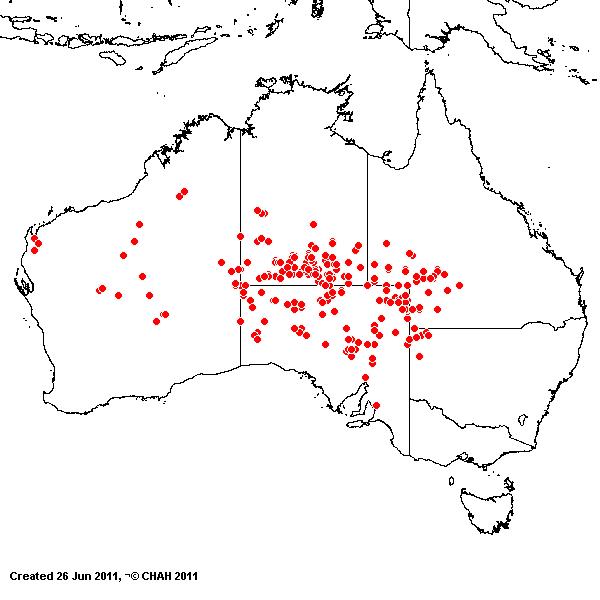Plagiosetum refractum (F. Muell.)Benth. Hooker's Icon. Pl. 13: 33, t. 1242 (1877)
Classification.
(GPWG 2001) : Subfamily Panicoideae. Paniceae.
Basionym and/or
Replacement Name: Setaria
refracta F. Muell., Fragm. 3: 147 (1862).
Type of Basionym or
Protologue Information: Australia]: "Ad rivum Cooper's Creek legit sub
expeditions Howittiana Dr. J. Murray.",.
Recent synonyms:
Plagiosetum refractum (F.Muell.) R.D.Webster
Key references
(books and floras): [1878] G.Bentham, Flora Australiensis 7 (494), [1952] C.A.Gardner, Flora of Western Australia 1 Gramineae
(290 ), [1981] M.Lazarides in J.Jessop (ed)., Flora
of Central Australia (482), [2002] D.Sharp &
B.K.Simon, AusGrass, Grasses of Australia as Paractaenum, [2006] J.Jessop,
G.R.M.Dashorst, F.M.James, Grasses of South Australia (467) as Paractaenum, [2008]
S.W.L.Jacobs, R.D.B.Walley & D.J.B.Wheeler, Grasses of New South Wales
(342)
Illustrations:
[1952] C.A.Gardner, Flora of Western Australia 1 Gramineae (291,
Pl.85), [2006] J.Jessop, G.R.M.Dashorst, F.M.James, Grasses
of South Australia (466, fig. 400) as Paractaenum, ,
[2008] S.W.L.Jacobs, R.D.B.Whalley & D.J.B.Wheeler, Grasses of New South
Wales, 4th edn (342).
Habit. Annual.
Culms erect or decumbent, 20–60 cm tall. Ligule a fringe of hairs, 1–1.5 mm
long. Leaf-blades convolute, 2–13 cm long, 2–5 mm wide. Leaf-blade surface
scabrous.
Inflorescence.
Inflorescence compound, a panicle of racemes. Racemes 5–15, deflexed or
spreading, cuneate, 1–3.5 cm long, bearing 1–2 fertile spikelets on each.
Central inflorescence axis 10–20 cm long. Rhachis deciduous from axis.
Spikelets.
Spikelets pedicelled, 1 in the cluster. Involucre composed of bristles. Fertile
spikelets 2-flowered, the lower floret barren (rarely male), the upper fertile,
comprising 1 basal sterile florets, comprising 1 fertile floret(s), without
rachilla extension, lanceolate, dorsally compressed, 4.8–7.5 mm long. Rhachilla
internodes elongated between glumes.
Glumes. Glumes
similar, thinner than fertile lemma. Lower glume ovate, membranous, without
keels, 5–7 -nerved. Upper glume lanceolate, 4.8–6.9 mm long, membranous,
without keels, 13–19 -nerved. Florets. Basal sterile florets 1, barren,
without significant palea. Lemma of lower sterile floret 100 % of length of
spikelet, membranous, 13–19 -nerved.
Fertile lemma 4.1–6.1
mm long, without keel. Anthers 3.
Continental
Distribution: Australasia.
Australian
Distribution: Western Australia, Northern Territory, South Australia,
Queensland, New South Wales.
Western Australia:
Canning. Northern Territory: Central Australia North, Central Australia
South. South Australia: North-western, Lake Eyre, Nullabor,
Gairdner-Torrens Basin, Flinders Ranges. Queensland: Gregory North,
Gregory South, Mitchell, Warrego. New South Wales: North Far Western
Plains.
Notes.
Similar to Paractaenum novae-hollandiae except for the form of the primary
branches. The bristle in P. novae-hollandiae is unmodified or a simple
unbranched structure. In Plagiosetum refractum the primary branch usually
consists of 2 to 3 spikelets with each spikelet subtended by a branched
bristle. In this species a single bristle consists of an elongated axis with
secund alternating secondary bristles. On the upper part of the primary branch
these compound bristles lack a subtending spikelet. The presence of a branched
bristle is not unique to this species. The African genus, Streptolophus,
appears to have a similar structure. In addition, if the axis of a compound
bristle were reduced to a single point, the result may be similar to some
species of Setaria where many bristles subtend a single spikelet.
In shrub steppe
shrublands, acacia shrublands, arid tussock grasslands, and arid hummock
grasslands. Common in red sandy soils and sand dune areas of arid central
Australia. Flowers sporadically throughout the year.

